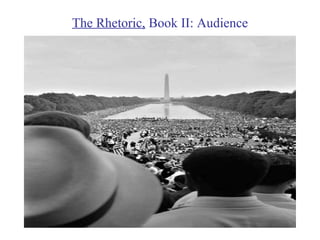Aristotle, the Rhetoric, Book II - Audience
•Télécharger en tant que PPT, PDF•
0 j'aime•593 vues
Signaler
Partager
Signaler
Partager

Recommandé
Виртуальная ИТ-инфраструктура предприятия на базе свободного ПО "под ключ"

Виртуальная ИТ-инфраструктура предприятия на базе свободного ПО "под ключ"St. Petersburg Foundation for SME Development
Эту презентацию и другие материалы Вы можете найти на сайте Евро Инфо Центра - Санкт-Петербург.
http://www.euro-info-center.ru/Организационно правовые формы предприятий, налогообложение, управление финанс...

Организационно правовые формы предприятий, налогообложение, управление финанс...St. Petersburg Foundation for SME Development
Деловые возможности региона Тампере - Кари Канкаала, Директор экономического и городского развития, г. ТампереДеловые возможности региона Тампере - Кари Канкаала, Директор экономического ...

Деловые возможности региона Тампере - Кари Канкаала, Директор экономического ...St. Petersburg Foundation for SME Development
Rubicon forum 2014 sponsorhip package enRubicon Forum 2014 Sponsorship package (English language)

Rubicon Forum 2014 Sponsorship package (English language)St. Petersburg Foundation for SME Development
Contenu connexe
En vedette
Виртуальная ИТ-инфраструктура предприятия на базе свободного ПО "под ключ"

Виртуальная ИТ-инфраструктура предприятия на базе свободного ПО "под ключ"St. Petersburg Foundation for SME Development
Эту презентацию и другие материалы Вы можете найти на сайте Евро Инфо Центра - Санкт-Петербург.
http://www.euro-info-center.ru/Организационно правовые формы предприятий, налогообложение, управление финанс...

Организационно правовые формы предприятий, налогообложение, управление финанс...St. Petersburg Foundation for SME Development
Деловые возможности региона Тампере - Кари Канкаала, Директор экономического и городского развития, г. ТампереДеловые возможности региона Тампере - Кари Канкаала, Директор экономического ...

Деловые возможности региона Тампере - Кари Канкаала, Директор экономического ...St. Petersburg Foundation for SME Development
Rubicon forum 2014 sponsorhip package enRubicon Forum 2014 Sponsorship package (English language)

Rubicon Forum 2014 Sponsorship package (English language)St. Petersburg Foundation for SME Development
En vedette (8)
Виртуальная ИТ-инфраструктура предприятия на базе свободного ПО "под ключ"

Виртуальная ИТ-инфраструктура предприятия на базе свободного ПО "под ключ"
Организационно правовые формы предприятий, налогообложение, управление финанс...

Организационно правовые формы предприятий, налогообложение, управление финанс...
Деловые возможности региона Тампере - Кари Канкаала, Директор экономического ...

Деловые возможности региона Тампере - Кари Канкаала, Директор экономического ...
Rubicon Forum 2014 Sponsorship package (English language)

Rubicon Forum 2014 Sponsorship package (English language)
Similaire à Aristotle, the Rhetoric, Book II - Audience
Similaire à Aristotle, the Rhetoric, Book II - Audience (20)
1 P o p u l a r C u l t u r e a n d M e d i a POPU.docx

1 P o p u l a r C u l t u r e a n d M e d i a POPU.docx
1 P o p u l a r C u l t u r e a n d M e d i a POPU.docx

1 P o p u l a r C u l t u r e a n d M e d i a POPU.docx
Plus de writRHET -
Plus de writRHET - (20)
1133 concrete vs. abstract - the easiest math quiz you've ever taken.pptx

1133 concrete vs. abstract - the easiest math quiz you've ever taken.pptx
concrete vs. abstract - the easiest math quiz you've ever taken.pptx

concrete vs. abstract - the easiest math quiz you've ever taken.pptx
concrete vs. abstract - the easiest math quiz you've ever taken.pptx

concrete vs. abstract - the easiest math quiz you've ever taken.pptx
Aristotle, the Rhetoric, Book II - Audience
- 1. The Rhetoric, Book II: Audience
- 2. What makes an audience rhetorical ? A rhetorical audience differs from other kinds of audiences (say, an audience at the movie theater) in that a rhetorical audience consists of people who, like the rhetor, can act upon the exigence that prompted the discourse. Perhaps they have the power to advance the rhetor’s purpose; perhaps they have the power to obstruct it; perhaps they can modify it; perhaps they can offer an alternative.
- 3. Name: Jennifer Jones: Age: 34 Residence: Lincoln, Nebraska Occupation: Graphic designer Political affiliation: Independent Religion: Methodist (non-practicing) Relationship status: Divorced Education: M.A. (Art history) Income range: $50,000–75,000 Homeowner (Y/N): Y Hobbies: Gardening, reading, cooking Favorite food: Italian Favorite color: Indigo Pet: cat The factual and the fictional audience The rhetorical audience has two “dimensions.” The first is what we’ll call the FACTUAL AUDIENCE. The factual audience is made up of the actual, flesh and blood people involved in the rhetorical situation. They can be described demographically, i.e., by age, residence, occupation, political and religious affiliation, categories of likes and dislikes, of beliefs and values, etc.
- 5. The factual and the fictional audience What we’ll call the FICTIONAL AUDIENCE is the one that the rhetor imagines and projects through his/her discourse — it’s the way the audience “sees” itself portrayed. To say that a rhetorical audience is partly a “fiction” doesn’t mean that the rhetor is lying, deluded, or just making stuff up. It means that, to argue persuasively, then, must project to her factual audience an an image with which they can identify, and one that will advance the rhetor’s purpose.
- 6. The factual and the fictional audience Sometimes that “fictional” image is projected via the way the rhetor talks to or about the audience. =
- 7. The factual and the fictional audience Sometimes that “fictional” image is projected via the way the rhetor talks about him- or herself.
- 8. The factual and the fictional audience And sometimes it occurs via the way the rhetor projects a relationship between him- or herself and the audience.
- 9. A good way to determine who the fictional audience, then, is to pay careful attention to the ways that the rhetor: — explicitly describes the audience — addresses him-/herself to them — “models” the audience through his/her own behavior — portrays his/her relationship with them — portrays the audience’s relationship to the exigence — portrays the audience’s relationship to one another AND ALWAYS ASK: WHY? That is, how does encouraging the audience to see themselves in this way advance the speaker’s purpose?
